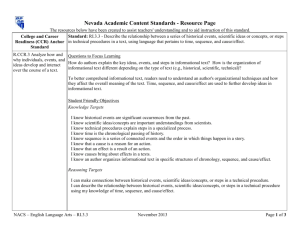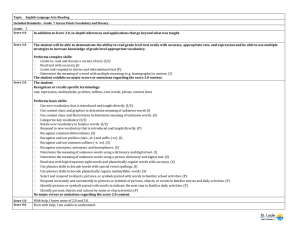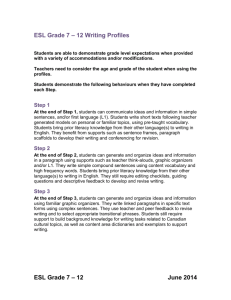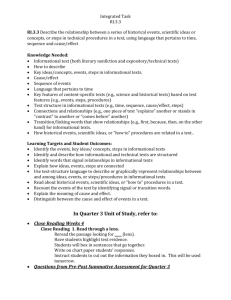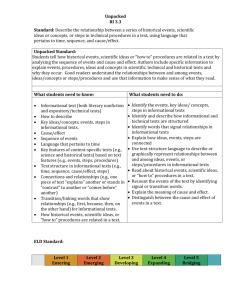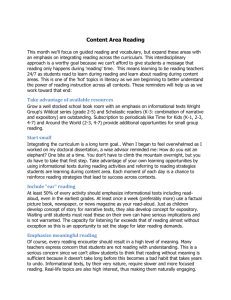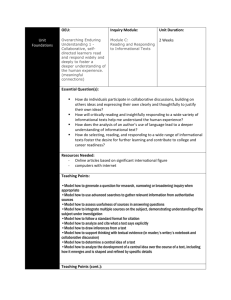Common_Core Stratagies Power Point
advertisement
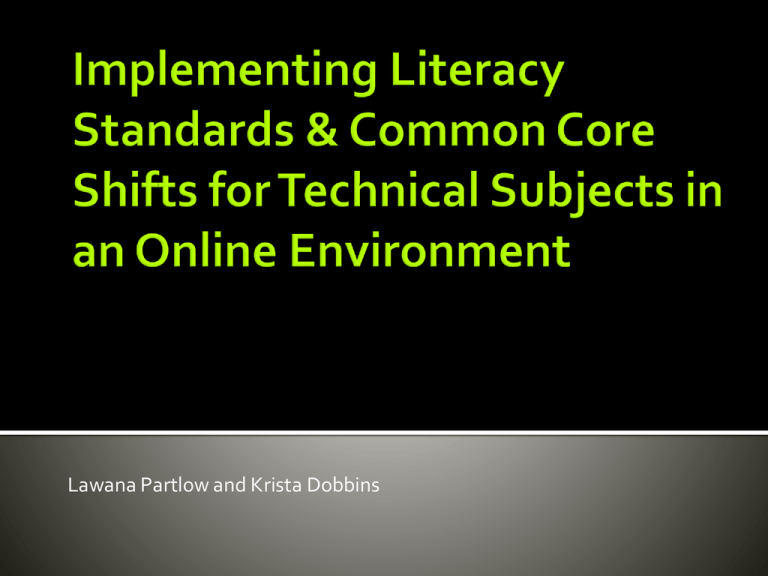
Lawana Partlow and Krista Dobbins 1. Literacy is EVERYONES job! 2. College and Career Readiness Being prepared for: A degree-granting postsecondary education, without remediation A chosen career, ready for advanced training. Let’s take a look at the shifts. What do they mean? What do they look like in my classroom? What tools and resources can I use? Shift 1 Teach through and with informational text. Provide more instructional text MS Level: 40% Literary to 60% Informational Text HS Level: 30% Literary to 70% Informational Text Ask thought provoking questions What were the important facts or information? Chunk text with questions that follow. Use Graphic Organizers to help them pull out information Shift 2 Students are expected to learn from what they read. Close Reading Discovery Learning Promote Evidence, Proof, and Sources Provide Study Guides, Guided Notes, Graphic Organizers Let students choose tools Ask thought provoking questions Chunk Text: Provide Questions Summarize Thinking and Writing Prompts Fill out the table below with the pros and cons of ____________. Pros (advantages - good things) Talk Show Cons (disadvantages- bad things) Shift 3 Provide appropriate and necessary scaffolding and support. What are YOU doing that STUDENTS could be, should be and would be doing on their own? Provide several optional organizers – let them choose best Slower take away options Restates the problem in your own words Draw picture or plan of attack CONCEPTUAL KNOWLEDGE CONNECTIONS & REPRESENTATIONS Show work or calculations Explanation for solution PROBLEM SOLVING COMMUNICATION Shift 4 Students think critically about text Form their own judgments Evidence based writing and conversations Evidence, Proof, and Sources Ask students to pull from multiple sources Compare/Contrast Can you prove ____________ using evidence from multiple resources? Give me a point from Author A that Author B may disagree with. Someone who reads this may quickly think __________, but if they really understand or look more closely they would know ___________________. In their writing, have them highlight the proof. Click and drag Provide multiple pieces of evidence from the text Some can be right, some wrong Prove or disprove it Rank the evidence Identify which piece is stronger and why Shift 5 Students develop responses to the information presented in the texts Develop and articulate their own conclusions about what they read and provide evidence Write from multiple sources Both short, frequent research and sustained long research Provide multiple articles Ask students to find one of their own that supports/ refutes the topic. Have questions that pull multiple texts together. Have students “argue” their position based on the texts. Shift 6 Vocabulary across all grades and content areas Focus on commonly found words Teach fewer words, but more deeply Provide support so students can “discover” the more challenging words. Three-Way Tie I Know What I Know Frayer Model I know what I know about _____________: First, I know _________________________________ ____________________________________________ In addition, I know ___________________________ ___________________________________________ Finally, I know __________________________ _______________________________________ Now, you know what I know about __________ Definition (in own words) Characteristics Examples Non-Examples I know what I know about _Common Core____: First, I know _________________________________ ____________________________________________ In addition, I know ___________________________ ___________________________________________ Finally, I know __________________________ _______________________________________ Now, you know what I know about _Common Core__ Directions: Move the statements and images below into the correct location. Students used annotation tools to fill in information. Entrance/Exit Ticket Strategy Personal Art Definition BEFORE PRESENTATION AFTER PRESENTATION Admit/Exit Strategy Understanding email and the internet can help you use the internet safely and wisely. Can your employer look at your employee email account? “Headline It” Activity Material Safety Data Sheet – Assignment 2 Directions: Use the information found on the MSDS to answer the following questions. What is the product name? Is this product flammable? Why should you keep this product away from heat, sparks and flame? What are symptoms of overexposure (Look in Signs and Symptoms)? What should you do if this product comes in contact with the skin? Why do you think there are firefighting measures listed? Describe a situation where you might need to know information on a MSDS sheet? ABC Graffiti Strategy Writing Strategy Directions for the weekly journal: Answer in this format. 1. Restate the question 2. Provide three additional sentences that support your view. These three supporting details should be pieces of evidence from your readings in the lesson. • Remember, these should back up your claims and be evidence from your weekly lessons. Research & Writing Strategy: Part 1 Research & Writing Strategy: Part 2 F.A.C.T - (Feelings, Actions, Changes, Threats) “Defense Mechanisms”

